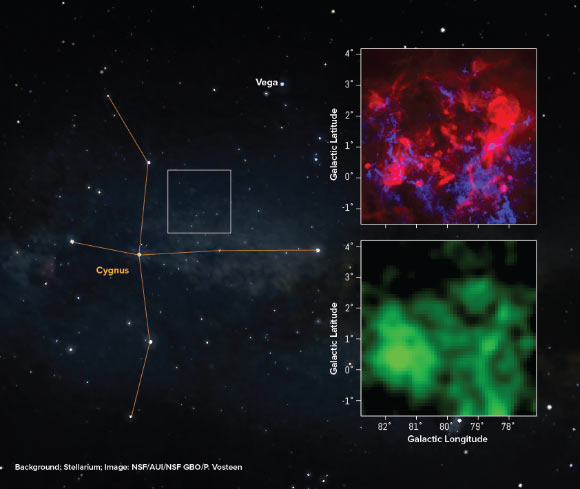Astronomers using the Green Bank Telescope (GBT) have created the large-scale maps of carbon monoxide (CO)-dark molecular gas for the star-forming complex Cygnus X.

These images show the location of CO-dark molecular gas in Cygnus X. Image credit: NSF / AUI / NSF’s NRAO / P.Vosteen.
For decades, scientists have known that most new stars are born inside clouds of cold molecular hydrogen gas.
Much of this molecular hydrogen is invisible to most telescopes — it doesn’t give off light that can easily be detected.
Traditionally, astronomers have hunted for these clouds by looking for carbon monoxide (CO), a molecule that acts like a flashing sign for star-building regions.
However, it turns out there’s a lot of star-forming gas that doesn’t ‘light up’ in CO.
This hidden material — CO-dark molecular gas — has been one of astronomy’s biggest blind spots.
In the new research, NRAO astronomer Kimberly Emig and colleagues mapped this hidden gas over a huge swath of sky by observing the radio spectral lines from atoms recombining, known as Carbon Radio Recombination Lines (CRRLs).
The team’s map covers Cygnus X, a star-forming region about 5,000 light-years away in the constellation of Cygnus.
“It’s like suddenly turning on the lights in a room and seeing all sorts of structures we never knew were there,” Dr. Emig said.
The new map reveals a vast network of arcs, ridges, and webs of dark gas weaving through Cygnus X.
These shapes show where star-making material is gathered and grown, before it becomes visible as before it becomes visible in CO as molecular clouds.
The authors demonstrated that these faint carbon signals, detected at very low radio frequencies, are an incredibly powerful tool for uncovering the hidden gas that directly connects ordinary matter with the formation of new stars.
They discovered that this dark gas is not just sitting still; it’s flowing and shifting, and moving with velocities much higher than previously realized. These turbulent flows can shape how quickly stars can form.
They also found that the brightness of these carbon lines is directly linked to the intense starlight bathing the region, highlighting the powerful role that radiation plays in galactic recycling.
“By making the invisible visible, we can finally track how raw material in our Galaxy is transformed from simple atoms into the complex molecular structures that will one day become stars, planets, and possibly life,” Dr. Emig said.
“And this is just the beginning of understanding these previously unseen forces.”
The results were published on October 17 in the Astrophysical Journal.
_____
Kimberly L. Emig et al. 2025. Cool Dark Gas in Cygnus X: The First Large-scale Mapping of Low-frequency Carbon Recombination Lines. ApJ 992, 216; doi: 10.3847/1538-4357/adfa17







